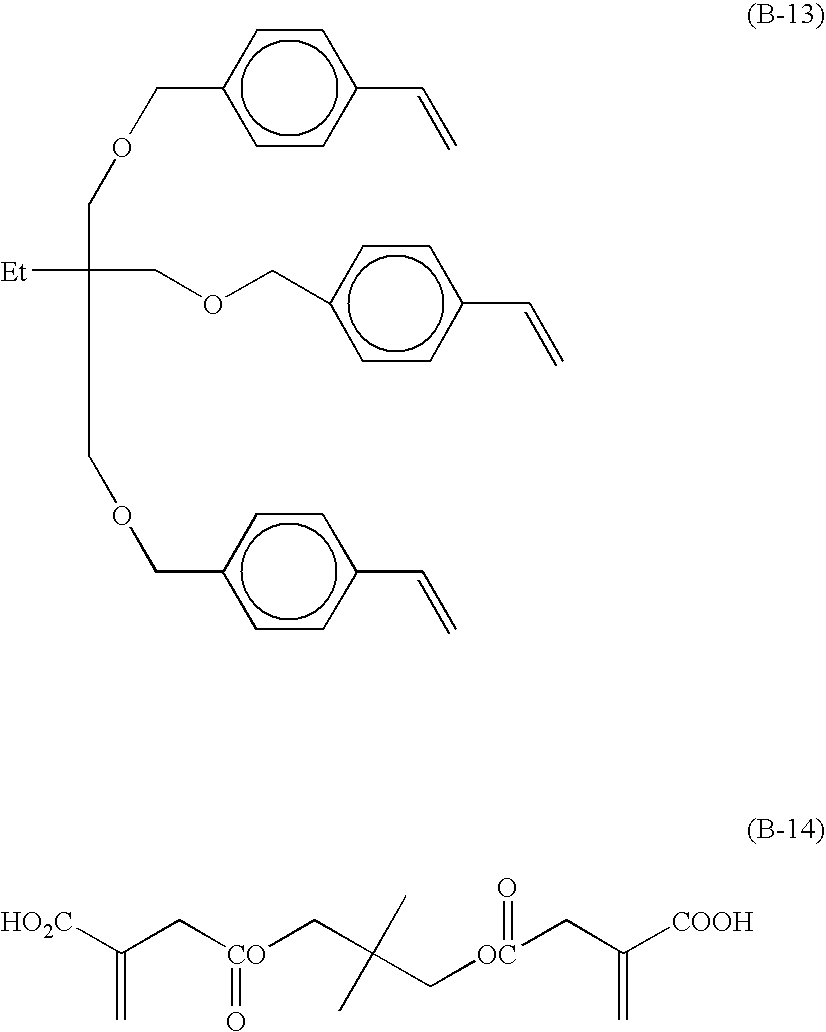Radical polymerizable composition and lithographic printing plate precursor using the same
a technology of lithographic printing plate and polymerizable compound, which is applied in the direction of auxillary/base layers of photosensitive materials, instruments, photosensitive materials, etc., can solve the problem of insufficiently satisfying results that cannot be obtained by conventional techniques, the difference between the reactivity of the polymerizable compound's reactivity of a polymerizable group introduced into the alkali-soluble resin and the reactivity of a polymerizable compound is small,
- Summary
- Abstract
- Description
- Claims
- Application Information
AI Technical Summary
Benefits of technology
Problems solved by technology
Method used
Image
Examples
synthesis example 1
Synthesis of Polymerizable Alkali-Soluble Resin (A-1)
In a 1,000 ml three-necked flask equipped with a condenser and a stirrer was put 30 ml of N,N-dimethylacetamide, followed by heating to 70° C. Under nitrogen gas stream, 300 ml of N,N-dimethylacetamide solution containing M-1 shown below (0.5 mol), methyl methacrylate (0.3 mol), methacrylic acid (0.2 mol) and 2′-azobis(2-methylbutyronitrile) (manufactured by Wako Pure Chemical Industries, Ltd.) (0.001 mol) was dropwise added over a period of 2.5 hours, followed by subjecting to reaction at 70° C. for 2 hours.
The reaction solution was diluted with 300 ml of N,N-dimethylacetamide, cooled to a room temperature and 4-hydroxy-2,2,6,6-tetramethylpiperidin-1-oxyl (free radical) (0.2 g) and tert-butanol (5 g) were added thereto. Then, 1,8-Diazabicyclo[5.4.0]-7-undecene (0.8 mol) was dropwise added to the reaction solution at 0° C. over a period of 2 hours, followed by stirring at a room temperature for 24 hours. The reaction solution ...
synthesis example 2
Synthesis of Polymerizable Alkali-Soluble Resin (A-23)
In a 1,000 ml three-necked flask equipped with a condenser and a stirrer was put 30 ml of N,N-dimethylacetamide, followed by heating to 70° C. Under nitrogen gas stream, 300 ml of N,N-dimethylacetamide solution containing M-2 shown below (0.5 mol), phenyl methacrylate (0.3 mol), methacrylic acid (0.2 mol) and 2′-azobis(2-methylbutyronitrile) (manufactured by Wako Pure Chemical Industries, Ltd.) (0.001 mol) was dropwise added over a period of 2.5 hours, followed by subjecting to reaction at70° C. for 2 hours. The solution was poured into water (5 liters) with vigorous stilling, followed by stirring for one hour. The white solid thus deposited was collected by filtration and dried to obtain Polymerizable alkali-soluble resin (A-23) according to the invention.
Resin (A-23) obtained was subjected to measurement by a gel permeation chromatography method to find a weigh average molecular weight of 106,000 calculated in terms polysty...
synthesis example 3
Synthesis of Polymerizable Alkali-Soluble Resin (A-30)
In a 1,000 ml three-necked flask equipped with a condenser and a stirrer was put 30 ml of N,N-dimethylacetamide, followed by heating to 70° C. Under nitrogen gas stream, 300 ml of N,N-dimethylacetamide solution containing hydroxyethyl methacrylate (0.5 mol), methyl methacrylate (0.2 mol), methacrylic acid (0.3 mol) and 2′-azobis(2-methylbutyronitrile) (manufactured by Wako Pure Chemical Industries, Ltd.) (0.001 mol) was dropwise added over a period of 2.5 hours, followed by subjecting to reaction at 70° C. for 2 hours. The reaction solution was cooled to 0° C., crotonic chloride (0.55 mol) was dropwise added thereto with stirring, and the solution was subjected to reaction for 12 hours while gradually raising temperature of the solution to a room temperature. The solution was poured into water (5 liters) with vigorous stilling, followed by stirring for one hour. The white solid thus deposited was collected by filtration and dri...
PUM
| Property | Measurement | Unit |
|---|---|---|
| wavelength range | aaaaa | aaaaa |
| wavelength range | aaaaa | aaaaa |
| wavelength | aaaaa | aaaaa |
Abstract
Description
Claims
Application Information
 Login to View More
Login to View More - R&D
- Intellectual Property
- Life Sciences
- Materials
- Tech Scout
- Unparalleled Data Quality
- Higher Quality Content
- 60% Fewer Hallucinations
Browse by: Latest US Patents, China's latest patents, Technical Efficacy Thesaurus, Application Domain, Technology Topic, Popular Technical Reports.
© 2025 PatSnap. All rights reserved.Legal|Privacy policy|Modern Slavery Act Transparency Statement|Sitemap|About US| Contact US: help@patsnap.com



